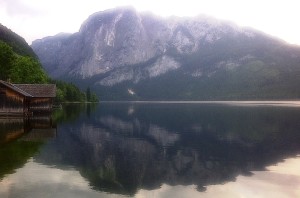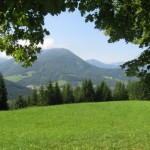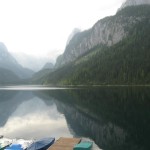Escaping the Heat by Indulging in some “Summer Freshness”

(Ich sehne mich hinaus wie noch nie.)
– Austrian Painted Gustav Klimt, August 1, 1901 in a postcard from Vienna sent to his lady, Emilie Floge at Attersee (the lake in the countryside)
Austrian writers and artists have a long tradition of escaping the oppressive summer heat of Vienna (or maybe they are slipping away from the tourists?) to spend some cool and artistically productive weeks in the Austrian countryside and the Alps. They even had a special word for this – not vacation, not holidays, but rather “Sommerfrische” – Summer Freshness.
Sommerfrische referred not only to annual retreat time but also to the destination. When noticing the absence of their beloved coffeehouse poet, patrons of Cafe Central may have asked, “Where praytell is Peter Altenberg these days?” Whereupon the Oberkellner Franz would have no doubt responded, “My madam, Herr Altenberg is currently on Sommerfrische until the end of August.”
The idea of retreating to the countryside during the summer probably dates back to the time of the aristocrats (evidenced in the stories of Jane Austen or Dostoyevsky) in which the landowners had to tend to their fields in summer and returned to the cities for their dose of society and culture in the winter months (where also, no doubt, heating a city flat was much more manageable than maintaining a whole countryside villa or palace throughout the winter). This is why you will still find summer palaces (Schönbrunn which was at one time quite a bit of travel per horse and carriage from the city) as counterparts to the winter palaces (Hofburg).
As transportation improved, and with the advent of train travel, a greater part of society began taking off for Sommerfrische revitalization. Evidence of some of the most popular destinations remains today in the form of opulent Jugendstil train stations more befitting royalty than the local countryside folk. Those who could not afford a countryside home stayed in Pensionen and hotels. In some of these popular villages you can still find “Kursalons” where turn of the century Viennese would gather to waltz their summer nights away (because a Viennese cannot not waltz, even on vacation).
In addition to dancing, the Sommerfrischler liked to hike, swim, boat, sing, play music, take walks, play chess and one can only imagine stir up trouble for the locals.
Another beloved past time of the Sommerfrische, was the so-called Liebeleien or Gespüssis. Fresh air? Fresh faces? Or the distance that often separated a husband and wife for several weeks at a time (with wife and children tucked away in the countryside while the man often had “important business matters” to attend to in the city)? The fragrant wild lilac bushes, the potent self-brewed Schnaps and thousand-star night skies? These were a particularly “hot” (no pun intended) topic for the writers and many works written during the turn of the century expound on some of these passionately tragic liaisons.
Of course, some say that perhaps so many went on Sommerfrische, not for salacious entertainment, but rather as an act of succumbing to social pressure — who wants to be accused of being too cheap or poor to send the family away for some Alpine recuperation? Favored Austrian Sommerfrische destinations that are still wonderfully suitable today for a cool summer visit with some beautiful traditional Austrian guesthouses:
Semmering
Rax
Payerbach
Salzkammergut: Wolfgangsee, Mondsee,
Joglland
Wienerwald
Kamptal
Weyer: Austrian poet, Peter Altenberg
And the favored swim destinations — Bad is a false cognate meaning “Bath”, NOT bad as in the opposite of good.
Bad Gastein
Bad Fusch
Altaussee
Bad Aussee
Bad Vöslau: Austrian writer, Arthur Schnitzler
Bad Ischl: the Emperor Franz Josef, Johann von Nestroy, Karl Kraus, who noted how many villas were being built for Viennese summer enjoyment, and commented that the mountains started to look more like decorations that had been put up around the Viennese Ringstrasse. 
More interesting reading on Sommerfrische:
Presse Article on Sommerfrische






Trackbacks & Pingbacks
Comments are closed.